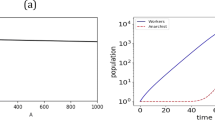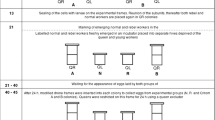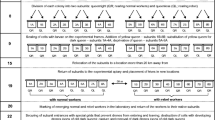Summary.
Worker bees eventually begin laying eggs in honey bee colonies that have lost their queen and have failed to rear a replacement. In contrast, workers tend to lack developed ovaries and tend to suppress drone production by worker nestmates in colonies with queens. We measured changes in worker egg-removal behaviour, ovary development, and egg-laying rate in hives following the removal of their queens. We carried out weekly assays of worker removal of experimentally transferred eggs, dissection and inspection of worker bee ovaries, and daily checks of worker oviposition. Following queen removal, the egg-removal rate by workers generally first increased, then decreased or levelled off over the four-week time course of the experiment; this behaviour was closely synchronized with the increase in worker ovary development and egg-laying. We discuss our results in the context of theoretically predicted worker-worker conflict over the onset of reproduction in queenless honey bee societies.
Similar content being viewed by others
Author information
Authors and Affiliations
Additional information
Received 7 July 2000; revised 12 February 2001; accepted 19 March 2001
Rights and permissions
About this article
Cite this article
Miller III, D., Ratnieks, F. The timing of worker reproduction and breakdown of policing behaviour in queenless honey bee (Apis mellifera L.) societies. Insectes soc. 48, 178–184 (2001). https://doi.org/10.1007/PL00001762
Issue Date:
DOI: https://doi.org/10.1007/PL00001762




